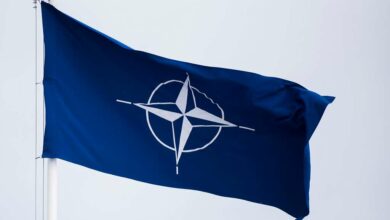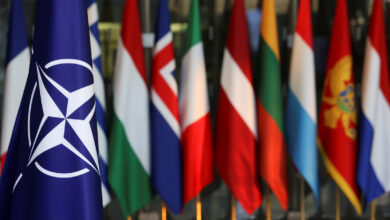
The North Atlantic Treaty Organization’s (NATO) ex-chief and current advisor to President Zelenskyy of Ukraine, Anders Rasmusse during a June interview with The Guardian said that, ‘If NATO cannot agree on a clear path forward for Ukraine, there is a clear possibility that some countries individually might take action…”.
Recent events in Ukraine have portrayed NATO as a significant instrument in global geopolitics. Yet, a closer examination of its history and current engagements reveals that events are often dictated by individual nations’ interests, rather than their commitment to NATO.
As indicated by Rasmussen’s statements, there is nothing that prevents individual member countries from participating in events NATO refused to partake in.
Likewise, there is nothing that binds them from participating in events the alliance engages in.
This suggests that the outcomes of such events would likely unfold similarly, irrespective of NATO’s presence or absence. Historical events also demonstrate the inconsequential impact of NATO’s involvement, as countries simply chose to participate under alternative coalitions or alliances.
The fate of Saddam Hussein in Iraq would likely have been the same if NATO had been involved instead of the coalition of the willing, which the US formed when there was no consensus within NATO.
Similarly, the fate of Muammar Gaddafi in Libya would not have been different if handled by a Western coalition instead of NATO.
Countries joining NATO gain access to direct benefits like intelligence sharing, weapons interoperability, and joint military exercises.
Most importantly, they benefit from deterrence, which NATO refers to as the core element of its overall strategy. This principle commits member states to consider an armed attack against one as an attack against all, as stipulated in Article 5 of NATO’s doctrine.
But again, the established mechanisms for joint training and shared intelligence can be—and often are—conducted outside the framework of the alliance. NATO’s partnership with Ukraine, a non-member, in arming and training its forces to NATO standards, is case in point.
An argument could be made that joining NATO today sends a political message, perhaps a unified stance against Russia’s actions.
But even this symbolism seems inconsistent.
The political messages of member states like Turkey and Hungary significantly diverge from NATO’s shared objectives. The former by buying the Russian S-400 and the latter by refraining from providing any military assistance to Ukraine. Both are keen on keeping strong economic and political ties to Russia, driven by national interests and away from fellow NATO member stances.
Even the US, the principal architect and supporter of NATO, saw its commitment to the alliance fluctuate under the Trump administration.
Turning to the argument of deterrence, one can only imagine various scenarios, given that Article 5 has only been invoked once after 9/11 and it was against terrorism, not a specific country.
Later, when Afghanistan and Iraq were identified as targets, military operations were not led by NATO and each country decided on the nature of its own response.
Russia has expressed conditional indifference to Finland’s and Sweden’s admission to NATO since there are no territorial differences with these two countries, and as long as no military infrastructure is deployed there.
It has stated that it would respond ‘symmetrically’ if this happens. If Finland, a NATO member, and Sweden a non-member, were to deploy missiles targeting Russia, Russia’s response towards these two nations will probably be the same.
Deterrence is also a two-way street.
As stated in a piece on NATO’s website, deterrence is undermined if not accompanied by actions in line with the deterrent threat, a lesson learned from the UK’s experience in the Falklands. Putin has clearly demarcated Ukraine and Georgia as red lines since 2008.
His resorting to military action in 2008 and 2022, simply because there has been a threat to cross these red lines, has acted as a deterrent, preventing NATO from extending full membership to these nations till this day.
This situation, particularly in Ukraine, proved strategically advantageous for NATO.
By keeping it on the periphery, NATO was able to respond more flexibly to Russia’s invasion. Ukraine’s actions, while aligned with NATO’s objectives, won’t be perceived as a direct NATO intervention, thereby avoiding the kind of responses typically provoked by the actions of full members. We’ve seen NATO frequently reassuring Russia and the world that it is not a direct party to this conflict.
But if we assume the unlikely scenario of NATO allowing Ukraine into the alliance after the war or – even more unlikely – during the war, which will be discussed in NATO’s upcoming meeting in Vilnius, Lithuania. Would this escalation serve as a deterrent leading to Russia’s withdrawal? Or would it spark World War III?
Probably neither.
Upon close examination of actions and reactions of all parties involved since the onset of the war in Ukraine, it becomes evident that the geographical boundaries of the conflict predominantly dictate the levels of escalation in this war. Both the US and NATO have consistently made clear that they do not support any military operations on Russian soil, and Russia, in turn, has avoided attacking NATO members like Poland, despite its role in facilitating Western arms shipments to Ukraine.
Therefore, even if Ukraine were a NATO member, it’s unlikely that any country would escalate the conflict beyond Ukraine’s borders. The more than fifty NATO and non-NATO members who have been supporting Ukraine prior to its hypothetical NATO membership would likely continue their support, with only a few potentially deploying troops.
Countries considering an attack on Russian soil would risk a ‘symmetrical’ Russian retaliation on their territory, regardless of their NATO affiliation or status.
Despite the argument being made to downplay NATO’s influence on the ground, the symbolic significance of the speculative inclusion of Ukraine in NATO cannot be overlooked. This would be perceived as a major political blow to Russia.
However, the potential downsides might eclipse the perceived gains.
In reaction to such an eventuality, Russia might escalate its military operations to a full-scale war across all of Ukraine, leading to its further destruction.
Such an outcome for a newly inducted member would be undesirable and perceived as a defeat for NATO.
To counter such escalation, NATO would need to commit to financial and military support even more substantial than what has already been provided since the start of the conflict. Considering the financial, logistical, and industrial challenges, NATO will be reluctant to commit to such support, hence the likelihood of NATO accepting Ukraine seems low.
Once more, underscoring NATO’s limited influence in dictating the course of events on the ground.




